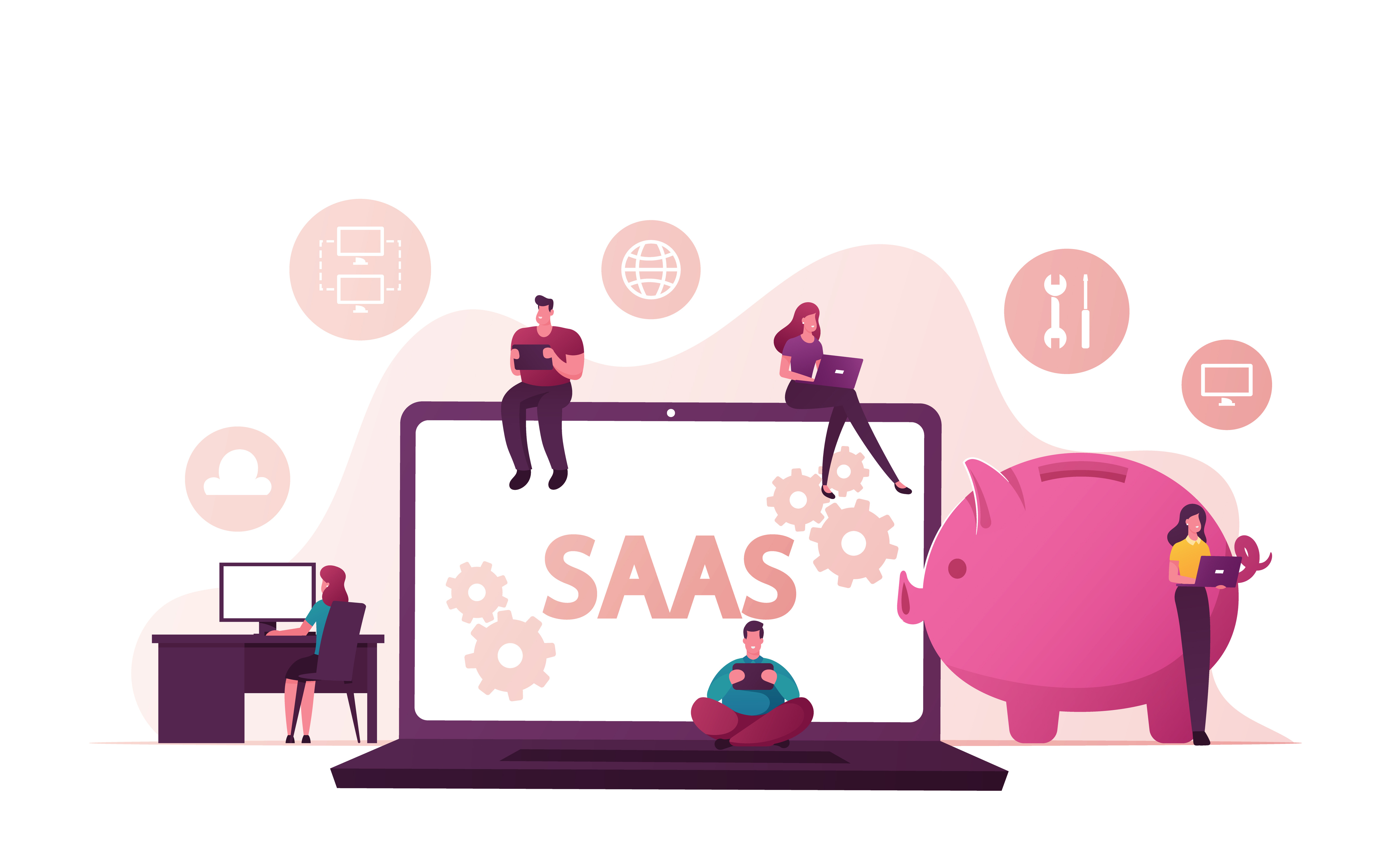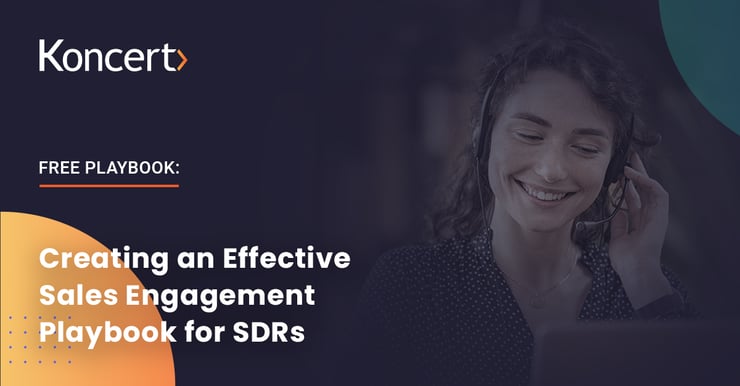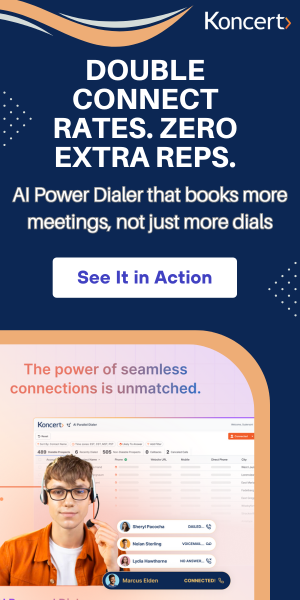11 min read
Saas Sales: Selling Software as a Service in 2022
By: Koncert Marketing on Aug 1, 2022 4:12:00 PM

What are SaaS Sales?
The software as a service (Saas) business model has grown exponentially for the past 20 years because it brings recurring revenue rather than single sales. SaaS sales follow a model of subscription-based software delivery in which users are given access to the software for a period, typically on a monthly or annual basis. As more and more businesses move to the cloud and have the capacity to add to their technology stack, these subscription-based products are exploding in use.
There are many benefits to selling SaaS, including providing users with a flexible and scalable solution that can be accessed from anywhere. In addition, SaaS sales commonly require a lower upfront investment than single-purchase, customized software sales, making it an attractive option for businesses of all sizes.
SaaS, however, is a complex sale. Providers must have a solid understanding of the market and the available options.
In this article, we'll review some of the basics of SaaS sales.
Working in SaaS Sales
Working in SaaS sales can be a great way to earn a good income. The average base salary for a SaaS sales position is around $87,000 per year. However, pay will vary based on experience, location, the size of the company, and other factors. You can often see your earnings broken down in detail on each paystub, which includes both base salary and commission earnings.
As a sales representative, you’re responsible for finding and contacting potential customers, negotiating contracts, and maintaining relationships with existing clients. Your salary would be based on your commission, so your earnings potential could be high.
Working in SaaS Sales can be a rewarding experience, but it is essential to remember that it is a demanding job. A sale is never really finished, and customer relationships must always stay nurtured. If you are prepared to work long hours and travel frequently, you may be well-suited for a career in SaaS Sales.
The Typical SaaS Sales Cycle
When it comes to SaaS, there is no one-size-fits-all sales cycle. The length and complexity of the sales funnel can vary greatly depending on factors such as the type of customer, the size of the enterprise, the price of the product, and whether or not demos and free trials are offered.
Type of customer. The journey a customer takes from awareness to purchase can vary depending on whether they are an individual consumer or a business. For example, an individual consumer may be more likely to buy a SaaS product after a free trial. At the same time, a company may require a more complex sales process, including demonstrations, presentations, and proposals.
Size of an enterprise. Larger businesses require a longer and more complex sales process due to their need for greater customization and support and the fact that larger companies have more individuals involved in the buying process, often across more than one department. Smaller companies and startups, on the other hand, may be able to move through the sales cycle more quickly since they often have a less complex set of requirements.
Price of the product. If the product is expensive, the customer may require more time to make a decision and may need to receive approval from multiple stakeholders.
Free trials and demos:
Customers who can try the product before buying it may be more likely to make a purchase, while those who cannot do so may require more time to make a decision. Good quality demos can show people features that they might not otherwise find on their own.
That said, there are some commonalities among SaaS sales cycles. Generally, the cycle can be broken down into four distinct stages: prospecting, pre-qualifying, demo/evaluation, and close.
- Prospecting: The sales cycle's first stage is generating leads. This can be done through various means, such as online advertising, social media, search engine optimization (SEO), trade shows, or word-of-mouth. Leveraging link building services can also enhance SEO efforts by increasing domain authority and driving organic traffic to attract potential leads.
- Pre-Qualifying: Once leads have been generated, the next step is pre-qualifying them. This involves determining whether or not they are likely to be interested in your product and capable of paying for it.
- Demo/Evaluation: If a qualified lead looks promising, the next step is to give them a demo of the product. This is an opportunity for them to see how your software works and decide if it’s a good fit for their needs. If the demo is successful, a free trial period may be offered here.
- Close: The final sales cycle stage is closing the deal. Negotiate the price and terms and have the customer sign a contract.
Keep in mind that the sales cycle can vary depending on the specific software product being sold and the type of customer being targeted. For example, smaller businesses or individuals may be more likely to make a purchase decision after a single demo. At the same time, larger enterprises may require a longer and more complex sales process.
Ultimately, the key to success is to keep the customer’s needs front and center throughout the entire cycle. By understanding what they are looking for and tailoring your approach accordingly, you can close more deals and keep your customers happy.
Types of SaaS Sales Models
There are various types of SaaS sales models, and here are some of the main ones:
- Self-service sales
- Enterprise sales
- Transactional sales
They differ in terms of pricing models, the extent of interaction with SaaS salespeople, and operational costs. Each has its own set of metrics that will showcase success rates.
Self-Service Sales
Self-service sales is a SaaS sales model in which the customer can sign up and purchase your product without the need for direct interaction with a sales representative. The key to making this model work is to have an intuitive and user-friendly product that doesn't require much hand-holding for the customer to get value from it. This is primarily a Business-to-Consumer model.
This model is often used by SaaS companies with a low price point who are targeting a more significant number of customers. It's more cost-effective to let the customer sign up and use the product on their own, rather than paying a sales team to reach out and sell to each individual.
The downside of this model is that it can be hard to upsell or cross-sell customers on additional features or products, as they’re not speaking with a SaaS sales rep who can guide them through the product and its capabilities.
If you're considering using the self-service sales model, make sure your product can stand on its own and that you have a way to track customer usage to identify opportunities for upselling or cross-selling down the line.
Enterprise Sales
Enterprise sales is a Business-to-Business SaaS sales model in which the customer is usually a large company or organization that requires a more complex solution than what’s offered in a self-service model. In this model, you'll have a team of sales reps responsible for reaching out to potential customers, building relationships, and eventually closing the deal.
This model is more expensive than the self-service model, as you're paying for a sales team who is taking the time to build relationships with targeted leads, but it can be worth it if you're targeting larger customers willing to pay more for a comprehensive solution.
However, the enterprise sales model can take longer to close deals, as you're dealing with larger organizations with their internal processes and decision-makers.
If you're considering using the enterprise sales model, ensure you have the resources to support your sales professionals and that your target audience is willing to pay for a more comprehensive solution.
Transactional Sales
Transactional sales is a SaaS sales model in which the customer purchases your product on a per-transaction basis. This model is often used by companies that offer a low-cost product or service, as it allows customers to pay only for what they use, rather than a flat monthly fee.
The key to making this model work is to have a pricing structure that is simple and easy to understand, as customers will need to be able to see the value in your product before they’re willing to make a purchase.
However, with the transactional sales model, it can be hard to upsell or cross-sell customers on additional features or products, as they’ve already made a purchase and may not be interested in spending more money.
If you're considering using the transactional sales model, make sure your pricing is simple and easy to understand and that you have a way to track customer usage to identify opportunities for upselling or cross-selling down the line.
Nourishing SaaS Sales
A healthy sales pipeline is the lifeblood of any SaaS business. It's what drives growth and keeps the company afloat.
Keeping a well-nourished and robust sales pipeline involves a targeted outreach, a well-oiled CRM sales strategy, sales and marketing teams working closely together, and a top-notch customer experience.
1. Establish Trial Periods
When selling software as a service, the key is establishing trust with potential customers. One way to do this is by offering a trial period before they commit to paying for your service.
A free trial is a great way to let inbound customers try out your product without risk. They can see first-hand how your product works and whether it meets their needs. This will help them see the value in your service and make them more likely to subscribe to it. Free trials also allow you to upsell customers on features they may not have known about.
You can then build trust with potential customers by getting feedback, which can be done through online reviews, testimonials, or case studies. Hearing about the success that others have had with your product will help ease potential customers' concerns.
2. Follow Up with Prospects
Follow up with qualified leads after they've expressed interest in your product. This shows that you're interested in their business and willing to help them succeed. It also allows you to answer any questions they may have about your service.
3. Offer Informational Demos
Informational demos are a great way to show potential customers how your product works and what it can do for them. This is a valuable step in selling SaaS because it helps establish trust and builds confidence in your product. It also allows you to implement an effective customer onboarding process and answer any questions that your new customers may have.
4. Upsell to Current Clients
Upselling to current clients is a great way to increase sales and revenues. When you upsell, you're offering your existing customers more value by providing them with additional features or services they may not have known about. It helps to have a dedicated account executive for your existing clients to address specific gaps, eventually building loyalty and increasing the lifetime value of your customers.
Excellent customer support plays a big role in upselling. It not only keeps the customer churn rate at bay but also demonstrates that your company sees customer success as front and center to your operations — building brand loyalty and inspiring them to try more of your offerings.
5. Harness the Power of Social Media
Social media is a powerful tool that can be used to generate leads and promote your product. By creating content that is interesting and informative, you can attract new customers and get them interested in what you have to offer.
Content marketing is an effective way to reach out to prospects and build your brand. By establishing your brand in the mind of your target audience while providing valuable information, you can generate B2B SaaS sales for your company.
By creating LinkedIn posts and similar content that center around helping your customers, you can build the credibility of your product and organization while attracting potential customers and getting them interested in what you have to offer — hitting both product marketing and lead generation strategies in one.
By utilizing the low customer acquisition cost (CAC) of social media, you'll be able to reach a wider audience and build relationships with potential customers.
Level Up Your SaaS Sales Process with Koncert
Koncert can help you take your SaaS sales process to the next level. Our platform provides sales tools that make it easy to manage leads, track opportunities, and close deals.
If you’re ready to take your SaaS business to new heights, contact us for a free consultation.
Related Posts
10 min read
High-Quality Outreach - Why Koncert's ZigZag Dialing® Replaces Call Blasting
Dec 12, 2025 by Koncert Marketing
13 min read
7 Outbound Sales Trends for 2026 - AI, Latency, & Max Connect
Dec 4, 2025 by Koncert Marketing




